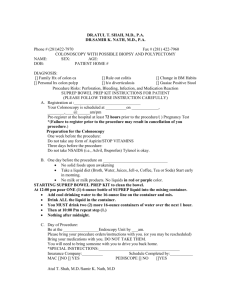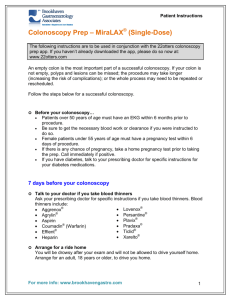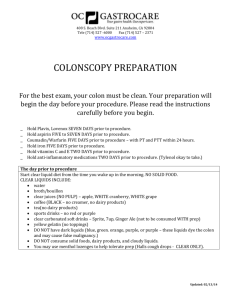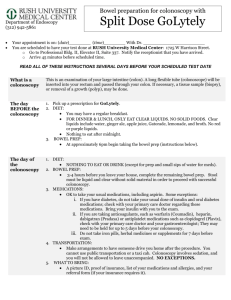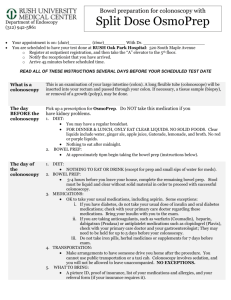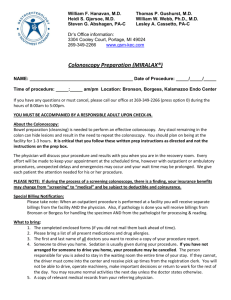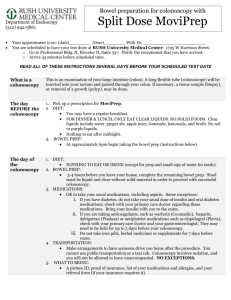expert - American Society for Gastrointestinal Endoscopy
advertisement
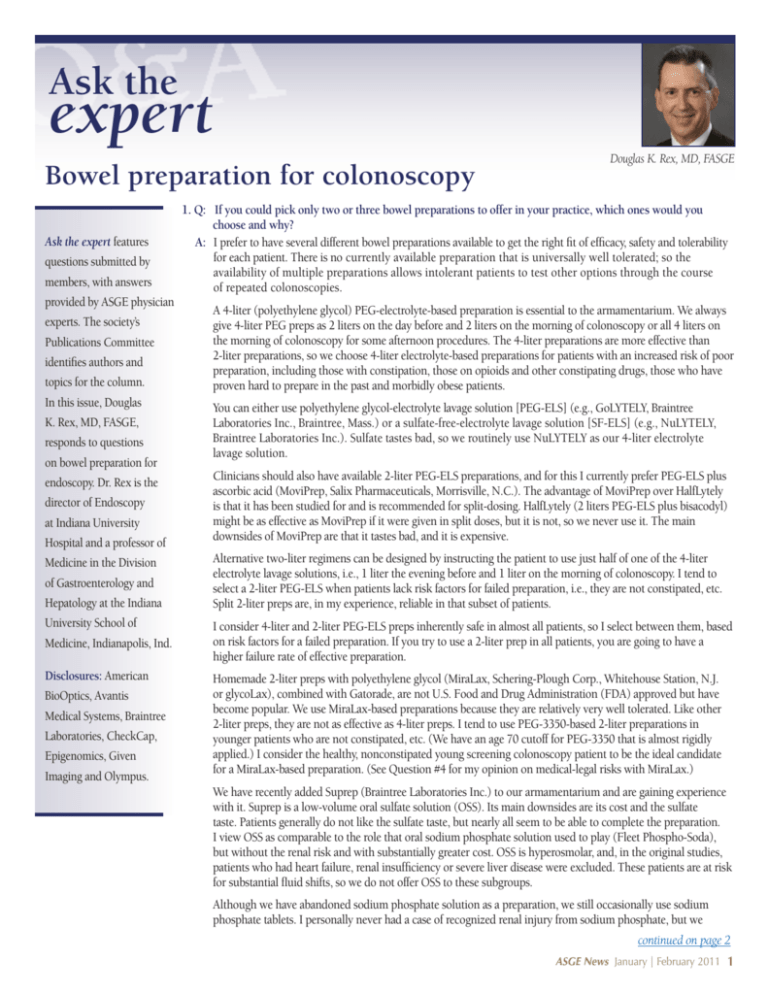
Ask the expert Bowel preparation for colonoscopy Ask the expert features questions submitted by members, with answers provided by ASGE physician experts. The society’s 1. Q: If you could pick only two or three bowel preparations to offer in your practice, which ones would you choose and why? A: I prefer to have several different bowel preparations available to get the right fit of efficacy, safety and tolerability for each patient. There is no currently available preparation that is universally well tolerated; so the availability of multiple preparations allows intolerant patients to test other options through the course of repeated colonoscopies. A 4-liter (polyethylene glycol) PEG-electrolyte-based preparation is essential to the armamentarium. We always give 4-liter PEG preps as 2 liters on the day before and 2 liters on the morning of colonoscopy or all 4 liters on the morning of colonoscopy for some afternoon procedures. The 4-liter preparations are more effective than 2-liter preparations, so we choose 4-liter electrolyte-based preparations for patients with an increased risk of poor preparation, including those with constipation, those on opioids and other constipating drugs, those who have proven hard to prepare in the past and morbidly obese patients. You can either use polyethylene glycol-electrolyte lavage solution [PEG-ELS] (e.g., GoLYTELY, Braintree Laboratories Inc., Braintree, Mass.) or a sulfate-free-electrolyte lavage solution [SF-ELS] (e.g., NuLYTELY, Braintree Laboratories Inc.). Sulfate tastes bad, so we routinely use NuLYTELY as our 4-liter electrolyte lavage solution. Clinicians should also have available 2-liter PEG-ELS preparations, and for this I currently prefer PEG-ELS plus ascorbic acid (MoviPrep, Salix Pharmaceuticals, Morrisville, N.C.). The advantage of MoviPrep over HalfLytely is that it has been studied for and is recommended for split-dosing. HalfLytely (2 liters PEG-ELS plus bisacodyl) might be as effective as MoviPrep if it were given in split doses, but it is not, so we never use it. The main downsides of MoviPrep are that it tastes bad, and it is expensive. Alternative two-liter regimens can be designed by instructing the patient to use just half of one of the 4-liter electrolyte lavage solutions, i.e., 1 liter the evening before and 1 liter on the morning of colonoscopy. I tend to select a 2-liter PEG-ELS when patients lack risk factors for failed preparation, i.e., they are not constipated, etc. Split 2-liter preps are, in my experience, reliable in that subset of patients. I consider 4-liter and 2-liter PEG-ELS preps inherently safe in almost all patients, so I select between them, based on risk factors for a failed preparation. If you try to use a 2-liter prep in all patients, you are going to have a higher failure rate of effective preparation. Homemade 2-liter preps with polyethylene glycol (MiraLax, Schering-Plough Corp., Whitehouse Station, N.J. or glycoLax), combined with Gatorade, are not U.S. Food and Drug Administration (FDA) approved but have become popular. We use MiraLax-based preparations because they are relatively very well tolerated. Like other 2-liter preps, they are not as effective as 4-liter preps. I tend to use PEG-3350-based 2-liter preparations in younger patients who are not constipated, etc. (We have an age 70 cutoff for PEG-3350 that is almost rigidly applied.) I consider the healthy, nonconstipated young screening colonoscopy patient to be the ideal candidate for a MiraLax-based preparation. (See Question #4 for my opinion on medical-legal risks with MiraLax.) We have recently added Suprep (Braintree Laboratories Inc.) to our armamentarium and are gaining experience with it. Suprep is a low-volume oral sulfate solution (OSS). Its main downsides are its cost and the sulfate taste. Patients generally do not like the sulfate taste, but nearly all seem to be able to complete the preparation. I view OSS as comparable to the role that oral sodium phosphate solution used to play (Fleet Phospho-Soda), but without the renal risk and with substantially greater cost. OSS is hyperosmolar, and, in the original studies, patients who had heart failure, renal insufficiency or severe liver disease were excluded. These patients are at risk for substantial fluid shifts, so we do not offer OSS to these subgroups. Although we have abandoned sodium phosphate solution as a preparation, we still occasionally use sodium phosphate tablets. I personally never had a case of recognized renal injury from sodium phosphate, but we Publications Committee identifies authors and topics for the column. In this issue, Douglas K. Rex, MD, FASGE, responds to questions on bowel preparation for endoscopy. Dr. Rex is the director of Endoscopy at Indiana University Hospital and a professor of Medicine in the Division of Gastroenterology and Hepatology at the Indiana University School of Medicine, Indianapolis, Ind. Disclosures: American BioOptics, Avantis Medical Systems, Braintree Laboratories, CheckCap, Epigenomics, Given Imaging and Olympus. Douglas K. Rex, MD, FASGE continued on page 2 ASGE News January | February 2011 1 Ask the expert continued from page 1 always used very aggressive hydration regimens with our sodium phosphate preps. We still allow occasional patients under 55 years of age (this was the original FDA restriction although it was subsequently removed) who have proven that they do not tolerate other preps, to use sodium phosphate tablets with an aggressive hydration regimen. To summarize, I think you must have a 4-liter PEG-ELS prep and probably should have a 2-liter PEG-ELS prep. I select patients for these based on the probability of a poor prep if only 2 liters are given. Finally, experience with OSS is increasing, and I think gastroenterologists will want to be able to offer this to interested patients. Based on the initial published trials, I think a significant fraction of patients will have a preference for OSS. Whether to include PEG-3350-based preps depends on your tolerance for medical-legal risk. There are, of course, other homemade bowel preparations for colonoscopy, including preparations based on magnesium citrate and preparations that combine various elements such as bisacodyl, PEG-3350 and magnesium citrate. I personally have no problems with colonoscopists relying on homemade regimens that have proven safe and effective in their practices. 2. Q: Calls at night from patients who are experiencing problems with their preps, even with split dosing, are a burgeoning burden for the on-call physician. What tips and tricks can you suggest to patients, during the office visit or when the preps are ordered, that will ultimately reduce the volume of night calls? A: If patients have had previous problems with vomiting when taking a bowel preparation, we tend to prescribe oral metoclopramide or promethazine prior to ingestion of the prep. We warn patients about extrapyramidal effects from metoclopramide (the greatest risk is in young women) and sedation with promethazine. I prefer that patients have a companion with them when we prescribe these agents. Ondansetron is a good choice, too. We do not use these agents routinely. Also, if there has been previous vomiting, I encourage the patient to take the first dose during the day so that he or she can call the office rather than the on-call person if there is a problem. The timing of the first dose is of no importance to the quality of the preparation; it is the timing of the second dose that is critical. In patients with severe vomiting, I sometimes have patients take 10 mg of bisacodyl two to three times on the day before the procedure, with each dose separated by six to eight hours, and then take large volume-tap water enemas on the morning of the procedure. My experience with PEG-3350-based preparations (MiraLax, glycoLax) is that they sometimes take longer to induce the first bowel movements, so we warn patients about that. Finally, I think that tolerability can be improved by allowing patients to eat a fiber-free diet on the day before the procedure. An example of a fiber-free diet can be found in Soweid et al.1 A fiber-free or low-residue diet for breakfast on the day before colonoscopy has been found to actually improve preparation quality, and a fiber-free diet has been shown to improve preparation quality and tolerability of the preparation compared with clear liquids. I am only gaining experience with this myself at the present time, but I anticipate that this approach will prove to be a real enhancement to preparation tolerability. Finally, another reason we receive so many calls is that we are doing so many colonoscopies; therefore, these calls are inevitable to some degree. We certainly want the patient who is in real trouble to call. 3. Q: A patient calls in the middle of the night to say that she has vomited her prep, and she is having no results so far. How do you respond if the call is at 7 p.m., 9 p.m., 11 p.m., or 6 a.m. the following morning? What tips do you have on how to salvage the situation, to allow for an alternative preparation and still keep the patient on time for her scheduled morning colonoscopy? A: If the patient calls the evening before and has vomited the prep, the first issue is to make sure that the vomiting has stopped. In the rare instance when the preparation induces protracted vomiting, no additional preparation should be given until the vomiting is under control with antiemetics. The patient who has protracted vomiting, particularly in combination with diarrhea induced by the prep, is a candidate to go to the emergency department. If the vomiting has resolved, we typically have the patient take either 10 mg of bisacodyl or a bottle (or about 10 ounces) of magnesium citrate, or both. Depending on how the patient is feeling, it may be best to give an antiemetic, with the same warnings described earlier, including making sure the patient is with a companion who can keep an eye on him or her. The latter is particularly important in an elderly person. The choice of continued on page 3 ASGE News January | February 2011 2 Ask the expert continued from page 2 preparation for the second dose the following morning is a matter of judgment, but if the patient feels the prescribed preparation was absolutely intolerable, then the morning dose should obviously be a different agent. If the patient calls after vomiting in the morning, then I would first ask what the effluent looks like. If the rectal effluent is clear or only yellow or green (with mucus only), then we tell the patient to come to the unit for the scheduled procedure. If the effluent is brown, I would do the same as advised above for the evening before and give either 10 mg of bisacodyl or 10 ounces of magnesium citrate. Contrary to some reports, I believe that the patient’s description of the rectal effluent does have some predictive value for the current quality of the preparation,2 and a patient reporting continued brown effluent is at increased risk of an inadequate preparation. 4. Q: Even though it is not FDA-approved, many gastroenterologists use “MiraLax” prep, a homemade concoction of MiraLax and Gatorade (238 grams MiraLax in 64 ounces of Gatorade). It does not require a prescription and is much less expensive than prescription products. However, I have concerns about safety issues with this prep, especially reports of hyponatremia and large volume shifts. Is this prep safe? If a patient has a serious side effect with this unapproved prep, is its use defensible in court? A: The MiraLax-based preparation is usually administered as half of a 238-gram bottle of PEG-3350 dissolved in 32 ounces of Gatorade and administered on the evening before colonoscopy, along with 10 mg of bisacodyl, followed by the remaining half of the MiraLax in 32 ounces of Gatorade the following morning. The advantage of this preparation is that it is low in volume and, anecdotally, tends to be well tolerated because it tastes like Gatorade (or whatever liquid the PEG-3350 is put in). In my opinion, this preparation is not as effective as a 4-liter PEG-ELS preparation, but it may well be as effective as a 2-liter PEG-ELS preparation. We do not give the MiraLax preparation to patients with constipation and other risk factors, because of the diminished efficacy, and we use an age cutoff of 70 because of concerns about hyponatremia (and the general observation that the older the patient, the more likely there will be a problem with the preparation, regardless of which one is used). Certainly Gatorade has a lower electrolyte content than PEG-ELS solutions and, therefore, could put patients at risk of hyponatremia. Having given this preparation to thousands of patients, I have yet to see a case of recognized hyponatremia or an instance of confusion in which I thought a serum sodium level should be drawn. Nevertheless, there are published3 and unpublished reports of hyponatremia with the preparation (as there are with all forms of bowel preparation for colonoscopy). I occasionally will let a patient in his or her 70s in good health take the MiraLax preparation if he or she has tried ELS preparations and found them intolerable. Personally, I have had many patients tell me that the MiraLax preparation was by far the best tolerated preparation they had ever used. It is important to remember that most cases of symptomatic electrolyte disturbance following bowel preparation occur in patients who are either elderly or have substantial comorbidities.4 This is my rationale for confining the MiraLax preparation to healthy patients under age 70 years. There is no evidence that split dosing is safer than evening-before dosing, but I find the idea of dividing the dose over time to be attractive as a potential means of decreasing the risk (already extremely low) of a symptomatic electrolyte disturbance. This suggestion requires further study. The issue of whether to use a non-FDA approved bowel preparation for colonoscopy is something that each colonoscopist must answer and depends on how he or she perceives his or her local medical-legal environment. I personally find it distasteful for pharmaceutical companies to suggest that colonoscopists using non-FDA approved preparations have liability for doing so, when they obviously are trying to sell their own FDA-approved preparations. In addition, I consider it unfortunate that FDA approval would be considered equivalent to the standard of care. We can all readily think of many examples in which that should not and cannot be the case. However, we all know that plaintiff’s attorneys might use lack of FDA approval to argue that MiraLax preparations are below the standard of care. Is it malpractice to use MiraLax? My answer is definitely not. However, another common answer is: “It is malpractice when the jury says it is.” continued on page 4 ASGE News January | February 2011 3 Ask the expert continued from page 3 5. Q: I still use the 4 liters of a PEG solution the day before and 1 bottle of magnesium citrate 4 hours before the patient leaves home on the day of the procedure. This prep works predictably well for my patients. Despite this, there are always patient complaints about the 4 liter volume. Many of the newer preps use a reduced volume or split dosing. Is there published evidence to prove conclusively that these newer preps are better? A: A preparation of 4 liters of PEG-ELS plus one bottle of magnesium citrate has not been studied, to my knowledge, and that is more preparation than is necessary for many patients. I suggest that you reconsider this approach. If you like to use 4 liters of PEG-ELS, the best way to give it is 2 liters on the evening before and 2 liters on the morning of the procedure. You could reserve your current preparation of 4 liters of PEG-ELS plus one bottle of magnesium citrate for patients whom you know are quite difficult to prepare, based on the factors I discussed earlier. The rationale for using 2-liter preps is that they are better tolerated in clinical trials than 4-liter preps. However, they are not as effective as 4-liter preps, with the failure rate (percentage of preparations that are inadequate) typically increasing from about 5 percent with 4-liter preps to around 10 percent with 2-liter preps. This is why I stratify my approach by using a 2-liter prep for non-constipated patients who are without other risk factors for a poor preparation and more extensive preps for those who need them. 6. Q: (a) Do we need to forget about the use of low-volume, phosphate-based bowel preps like Fleet Phosphosoda (now withdrawn from market in the U.S.) because of possible serious side effects? Many international ASGE members in other countries still continue to use it, seemingly without a problem. Should physicians in the U.S. still prescribe it? A: (6a) The days of oral sodium phosphate solution in the United States are largely over because of the medical-legal climate here, with lawyers running television and newspaper advertisements soliciting patients with kidney disease who have ever received sodium phosphate. The incidence of renal injury with sodium phosphate is actually unknown but is probably very low. As I noted earlier, I used it for about 20 years and never had a recognized case of renal injury. However, we did not use sodium phosphate as a low-volume preparation because we prescribed 4 liters of hydration with it. There is no question that renal injury can occur with sodium phosphate. The main risk factors are female gender and a diagnosis of hypertension. Given that we have alternatives, it makes sense to avoid sodium phosphate preparations. As I noted earlier, we still use the sodium phosphate tablets in rare instances. Q: (b) There is a new FDA-approved, low-volume bowel prep, Suprep, which is sulfate-based and is being marketed aggressively. Given that Suprep is new and there is limited post-marketing experience, how can we be sure that it is safe? Would you recommend it? A: (6b) Suprep [Braintree Laboratories] (OSS) does not contain phosphate. Sulfate is not absorbed as well as phosphate and, as far as we know, sulfate does not cause renal injury. I agree that there is no post-marketing experience. The advantages of OSS are the low volume and the good safety profile in the published clinical trials. The disadvantages are that the cost is high and sulfate does not taste good. I performed one of the clinical trials with Suprep, although, of course, I was blinded to which prep the patients were taking. I am only now accumulating clinical experience with OSS. Further, I am a consultant to Braintree (feel free to take that into account). My own (hopefully objective) recommendation is that given the poor tolerability of other FDA-approved bowel preparations for colonoscopy, I would at least gain some experience with prescribing OSS. Q: (c) Can Suprep be safely used in elderly patients or in patients with chronic kidney disease, heart failure or epilepsy? A: (6c) Patients with chronic kidney disease, heart failure and severe liver disease were excluded from the OSS clinical trials. Suprep is hyperosmotic and capable of inducing significant fluid shifts. I would not (and am not) using it in those groups at the present time. Further study is needed. I would also be cautious with OSS use in elderly frail patients because of its hyperosmotic nature and the risk of dehydration. I do not think there would be a problem in patients with a seizure disorder, since there was not a major issue in electrolyte disturbances in the OSS clinical trials. continued on page 5 ASGE News January | February 2011 4 Ask the expert continued from page 4 7. Q: I practice in rural South Carolina, the “colon-cleanser capital of the world.” In the past five years, atonic colons in morbidly obese patients have become a nightmare for us. Most of these colons are severely atonic, capacious, convoluted and hard to intubate due to chronic laxative use. We dread the gritty stools that clog the scopes. I have tried split-dosing preps, 2-day preps with front loading with magnesium citrate, a MiraLax-Gatorade prep, high-volume PEG preps and Suprep. Nothing works in some of these colons. We instruct patients and call them a day ahead with detailed instructions. At least 15 percent of our patients have an unacceptable prep, and 5 percent have preps that made the examination meaningless. What would you recommend? A: Since modern colon-cleansing agents are not believed to damage the colon or alter its anatomy, your description suggests a high prevalence of some dietary or other factor that has damaged these colons. Perhaps the patients are using cathartics because they have to. In any case, it sounds like a nightmarish situation for a colonoscopist. I suggest perhaps a week of a low-residue diet, completely devoid of seeds and nuts, followed by two consecutive days of split-dose PEG-ELS prep. I might give bisacodyl on both days also. In addition, when it becomes available, you may want to gain experience with the EasyGlide ClearPath (Wilmington, Del.), which is an irrigation-suction device attached to the side of the colonoscope. This device provides one method of salvaging a poorly prepped colonoscopy. Another alternative would be to ask these patients to undergo “colon hydrotherapy” or some other variation of per-rectal colonic lavage the day before colonoscopy. Perhaps you could set up your own commercial unit for “colon hydrotherapy” and charge patients to have their colons cleaned out the day before! I do not believe that there are any health benefits demonstrated for this type of therapy, but you might have struck on a bona fide need for it in rural South Carolina. Whether we should move toward fully preparing colons per rectum is an area that has received some attention in the past, will likely gain more attention and is clearly associated with substantial logistical and efficiency obstacles. 8. Q: Is split-dosing definitely superior to single-dosing of the same bowel prep? Can split-dosing be done with any of the bowel preps or only certain ones? A: Ten randomized controlled trials have compared split dosing to evening-before dosing, and all 10 found split dosing to have superior efficacy. Typically, split dosing is dramatically more effective, particularly for ascending colon cleansing. All of the trials also showed that tolerability was either equal or superior for split dosing. All currently available bowel preparations can be split. 9. Q: In implementing a split-dose prep, what is the optimal time for the morning dose? I am having difficulties because many of my patients drive a long distance and are having problems with the need to stop multiple times to use restrooms along the way. A: The optimal timing of the second dose has not been resolved. Our practice is to have patients begin the morning dose four to five hours before the time they are scheduled, and we ask them to have it completed by three hours prior to their scheduled time. The issue about long distance travel has not been adequately studied, but initial studies found that patients who took all of the prep the night before also have to stop sometimes on the way to the endoscopy unit. For those who can afford it, it is often preferable to travel the night before. We provide a list of local hotels and motels that patients can choose to stay at while they take the preparation. 10. Q: What do you do in patients who are scheduled for a 7 a.m. colonoscopy. Do you tell them to wake up at 2 a.m. to take the second dose of a split-dose prep? I do not think that many patients will do this in my practice. A: We ask all of our patients, including the 7 a.m. patients, to start the second dose four to five hours before they are scheduled for colonoscopy. Our surveys show that 80 percent of our patients scheduled between 7 and 9 a.m. actually awaken in the night and follow these instructions. Our preparation instructions send patients the message that we are serious about polyp detection and that the timing of the preparation is important to an effective examination. Having said that, is there a compromise position? If split dosing is too great a nuisance for the early morning colonoscopy patient, the second dose can be given late the night before the colonoscopy. Once the patient finishes the prep, the bowel preparation starts to deteriorate several hours later, and it deteriorates hour by hour. Therefore, admittedly, the practice of split dosing is more important for colonoscopies scheduled for later in the day than it is for those at 7 a.m. The patient who is scheduled at 7 a.m. and anticipates having difficulty with travel can probably continued on page 6 ASGE News January | February 2011 5 Ask the expert continued from page 5 take the second dose at about 11:00 p.m. and then sleep for a few hours and be driven to the endoscopy unit in the early morning. I should also note that it is clear that afternoon colonoscopy patients can take the entire preparation for colonoscopy on the morning of the examination. This is just as effective as split dosing, although we do not know if it is as well tolerated in the case of 4-liter preparations. However, it appears to result in less work disruption on the day prior to the examination. 11. Q: Some anesthesiologists are concerned about the timing of the second dose of a split-dose prep and whether the stomach has had enough time to empty before beginning sedation with propofol. What do you recommend? A: In 1999, the American Society of Anesthesiologists (ASA) issued a policy on fasting prior to sedation, stating that patients can take clear liquids until two hours prior to sedation or anesthesia5. The evidence to support this came from several studies in patients undergoing general anesthesia, in whom a nasogastric tube was placed at the time of initiation of anesthesia, and the gastric volume was measured and correlated with the time that the patient had stopped drinking clear liquids. Patients who had discontinued clear liquids two hours or earlier in these studies had residual gastric volumes that were not different from those of patients who were nil per os (NPO) for many hours. Therefore, the ASA recommendations are evidence based. In a recent study, we reported that residual gastric volumes in patients undergoing same day upper endoscopy and colonoscopy were the same (when measured during the upper endoscopy) if the patient had undergone split dosing or night-before dosing and that there was no correlation between residual gastric volume and the number of hours the patient had been NPO.6 Again, this evidence suggests that the ASA recommendation is evidence based. My recommendation is to show the anesthesiologists the evidence and ask them to acknowledge it. Having said that, residual gastric volumes are variable, and some individuals will have residual gastric volumes of 100 mL or more, even when they have been NPO for many hours. Patients undergoing colonoscopy do not have the airway protection of endotracheal intubation, and anesthesiologists often sedate them to the point of general anesthesia. I suspect that one of the downsides that we will eventually identify from the increasing use of anesthesiologists for endoscopic procedures is a measureable increase in the risk of aspiration pneumonia and other pulmonary infections following colonoscopy. Everyone should be vigilant regarding aspiration risk during colonoscopy. I would be especially careful when patients are turned to the supine position and if they begin to hiccough and/or cough during the procedure. Suction should be available at the mouth, and refluxed secretions should be drained from the mouth and pharynx as they appear. These precautionary measures are appropriate in deeply sedated patients regardless of when the last dose of preparation was taken. 12. Q: In patients with gastroparesis, does the timing of the split-dose prep vary? A: I cannot give you an answer based on evidence and recommend that you use your clinical judgment. 13. Q: In patients who are not cleaned out on the morning of a colonoscopy, what do you think about asking them to quickly drink a bottle of magnesium citrate two hours before the procedure? Is this practice effective and safe? A: Yes, I think it is safe to give additional preparation. Once that preparation is completed (regardless of which one it is), the patient should wait two hours before sedation is given. 14. Q: In the following clinical scenarios, what type of bowel preparation do you recommend for colonoscopy: A. Pregnancy B. Chronic kidney disease (not requiring dialysis) C. End-stage renal disease requiring dialysis D. Severe heart failure E. Critical aortic stenosis requiring surgery F. Gastroparesis A: A-E. These patients should be given PEG-ELS, either 4 liters or 2 liters, based on considerations discussed earlier. F. Any of the preparations that we have discussed is acceptable to use in gastroparesis. In a hospitalized patient with severe gastroparesis who requires colonoscopy, insertion of a nasoduodenal or jejunal tube for infusion of the prep can be considered. continued on page 7 ASGE News January | February 2011 6 Ask the expert continued from page 6 15. Q: I have some patients who state that they cannot tolerate any form of oral liquid bowel preparation because of severe nausea and vomiting. What would you recommend in this situation? A: I usually give the patient two or three doses of oral bisacodyl (usually 10 mg) about six to eight hours apart on the day prior to the examination. We then ask the patient to arrive early in the unit, and we give them largevolume tap water enemas until clear. 16. Q: Most bowel preparation instructions require patients to be on a clear liquid diet the day before a colonoscopy and on a light diet two days before. Many of my patients find it difficult to stop eating. I have seen advertisements about commercially available solid food diets before colonoscopy. My patients would love to continue to eat solid food while taking a bowel prep. Do these products work? A: The evidence in favor of a low-residue diet or fiber-free diet the day before colonoscopy is consistent and becoming more substantial. The initial studies looked at breakfast only followed by clear liquids, but a recent study of a fiber-free diet allowed patients three fiber-free meals the day before colonoscopy and compared this to clear liquids only.1 These studies have typically shown that patients who continue to ingest these diets actually have better bowel preparation quality and tolerate the preparation better. In a recent large study, patients who were eating the fiber-free diet actually completed more of the preparation than those who were on clear liquids. There has been speculation as to why the preparation would actually be better after eating a fiber-free diet compared with ingestion of clear liquids. The most common explanation offered is that food may be important for maintaining normal bowel motility, suggesting that clear liquids only induce hypomotility that makes the preparation more difficult to tolerate and to complete. 17. Q: Is a full colonoscopy bowel preparation still required for limited procedures, such as flexible sigmoidoscopy with argon plasma coagulation (APC) for radiation proctitis or flexible sigmoidoscopy with hot snare polypectomy for a residual rectal polyp? In these instances, what is the risk of colonic explosion if only a standard, low-volume enema bowel prep is used? A: Studies of intraluminal gas composition with and without bowel preparation have shown that some patients who take no preparation or take only enemas have measurable concentrations of explosive gases that could theoretically be at risk for an explosion with use of electrocautery. For that reason, when planning to use electrocautery (including APC) in the distal colon, I typically ask patients to take a full colonoscopy prep. Having said that, I admit that this may be “overkill,” because the risk of an explosion is probably exceedingly small. I certainly would not hesitate to proceed with electrocautery in a patient who did not take the prep or in an emergency situation. In those instances, the approach is simply to deflate the colon and inflate it several times to exchange intraluminal colonic gas for insufflated air or carbon dioxide. 18. Q: Most colonoscopists in Brazil use 10 percent mannitol for bowel preparation. Is the risk of colonic explosion affected by the type of bowel prep used, including sorbitol? A: Any nonabsorbable disaccharide that can be metabolized by bacteria theoretically poses an explosion risk. Because these events have been documented after mannitol use, I would not use it. The information presented in Ask the expert reflects the opinions of the author and does not represent the position of ASGE. ASGE expressly disclaims any warranties or guarantees, express or implied, and is not liable for damages of any kind in connection with the material, information, or procedures set forth. See next page for additional resources and references! continued on page 8 ASGE News January | February 2011 7 Ask the expert continued from page 7 Additional resources l Colonoscopy Technique: Basic and Advanced Endoscopic Learning Library DVD: Douglas K. Rex, MD, FASGE DV029 1.25 CME Credits, Member price: $125; non-member price: $175 l Colonoscopy and Upper Endoscopy: What Patients Can Expect Before, During and After a Procedure ASGE Patient Education DVD DVPE09, Member price: $10; non-member price: $15 l Understanding Colonoscopy Patient Education Brochure PEB05, Member price: $15 per packet of 50; non-member price: $22.50 per packet of 50 See pp. 14-15 for more resources or visit www.screen4coloncancer.org. References 1. Soweid AM, Kobeissy AA, Jamali FR, El-Tarchichi M, Skoury A, Abdul-Baki H, El-Zahabi L, El-Sayyed A, Barada KA, Sharara AI, Mourad F, Arabi A. A randomized single-blind trial of standard diet versus fiber-free diet with polyethylene glycol electrolyte solution for colonoscopy preparation. Endoscopy 2010;42:633-8. 2.Fatima H, Johnson CS, Rex DK. Patients’ description of rectal effluent and quality of bowel preparation at colonoscopy. Gastrointest Endosc 2010;71:1244-52. 3.Nagler J, Poppers D, Turetz M. Severe hyponatremia and seizure following a polyethylene glycol-based bowel preparation for colonoscopy. J Clin Gastroenterol 2006;40:558-9. 4.Belsey J, Epstein O, Heresbach D. Systematic review: adverse event reports for oral sodium phosphate and polyethylene glycol. Aliment Pharmacol Ther 2008;29:15-28. 5.Practice guidelines for preoperative fasting and the use of pharmacologic agents to reduce the risk of pulmonary aspiration: application to healthy patients undergoing elective procedures: a report by the American Society of Anesthesiologist Task Force on Preoperative Fasting. Anesthesiology 1999;90:896-905. 6.Huffman M, Unger RZ, Thatikonda C, Amstutz S, Rex DK. Split-dose bowel preparation for colonoscopy and residual gastric fluid volume: an observational study. Gastrointest Endosc 2010;72:516-22. ASGE News January | February 2011 8
